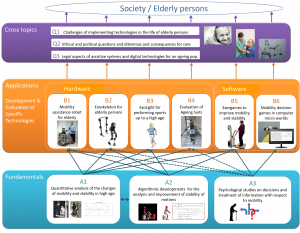To ensure output that acutally will contribute to improved mobility in older adults the project consists of an interdisciplinary consortium. This allows the project to cover every necessary aspect of research to succesfully introduce digital technologies and assistive systems in the life of the older adults and meet their specific needs. This research ranges from from the basic understanding of biomechanics of motion of every day movements, mathematical simulation of the effect of assistance, engineering of developing new technologies, and psychology to developing concrete technologies, and psychological insight into the use of devices by older adults. In addition, the project includes examination of any ethical, legal, and social aspects of the developed technologies.
The work program for this project is divided into three different methodical parts:
- Fundamentals A, in this part basic knowledge is taken as prerequisites for the development of intelligent systems, and fundamental algorithms are developed
- Application B, in this part concrete digital technologies and technical assistive systems, are developed for and evaluated in different groups of older people, and then evaluated
- Overlapping Topics Q, this part deals with the interdisciplinary validation and preparation of the public use/ general acceptance of digital technologies and robotic systems, thus, including the psychological, ethical, legal, social, nursing and political aspects

Basics A:
- A1: This part ensures an understanding of the movement abilities of older adults. Multiple biomechanical studies will be performed, in which we analyze the coordinated movements of different segments of the body with respect to each other during different tasks, such as walking and standing up from a chair.
- A2: Building on the results of part A1, algorithms will be developed, that allow a goal-oriented interaction of the user with digital technologies, like the assistive robot, or the virtual reality.
- A3: Mobility not only includes motoric capabilities but also decisions and planning. For young people this happens automatically, for the older adults, however, it is an active process. In this project part, we focus on this topic. We examine in which way assistive devices are used best to achieve the desired goal.
Application B:
- B1: This part’s goal is to develop an external assistive mobility robot – a robot rollator – for older adults people. The robot consists of a rolling platform and a movable structure with handholds on top, on which the user can hold him-/herself.
- B2: In this part, an existing exoskeleton will be tuned to assist the power and stability of the user, and prevent falling, to fulfill the need of the older adults.
- B3: The goal of this part is the development of an “Exosuit Light” or an orthosis, which allows older people with fairly high mobility (Frailty Level 3, “managing well”) to practice their preferred sport into high age.
- B4: Here we will research the impact of high age simulation suits on movement parameters and subjective images of old people. Even though there is a great interest in those suits, there is still a lot of research concerning the potential and boundaries of high age simulation suits needed.
- B5: This part’s goal is to further develop Exergames for the prevention/ rehabilitation of relevant cognitive and functional abilities in high age. This helps to keep/increase the mobility of the older adults.
- B6: As well as for the individual diagnosis as for capturing effects of training, we need measurement devices, which can show the status, and possible training-induced changes in mobility decisions. In the modern research of decision-making computer-based measurement instruments, which create a virtual environment in which users have to make decisions, are used. In this part, we focus on using such a measurement system effectively.
Overlapping Topics Q:
- Q1: The aim of this project is to combine feasibility and implementation testing for selected technologies in different HeiAge subprojects. The project heads to increase the acceptance of mobility supporting technologies among older adults and other stakeholders and to maximize the likelihood that the mobility supportive technology solutions developed in HeiAge (i.e., smart rollator, exoskeleton, exosuit) will see a range of suitable real-world applications. The involvement of potential end-users of the technologies into the research is realized by the user centered design (UCD) approach in which users directly and decisively influence the development of technology through their preferences. The results will allow to better understand why specific technologies find more acceptance than others. The project accords with HeiAge’s ambition in terms of serving older adults’ maintenance or regaining of mobility, connected with increased autonomy, self-efficacy, social participation, and well-being.
- Q2: The introduction of technical assistance, especially in cases, where it makes decisions for the user, creates ethical questions. Those questions are answered in this part.
- Q3: In the perspective of rights and law, this project researches two problems:
1. By using intelligent assistive systems various data – e.g. the user’s movement characteristics- is captured. Part of the most basic problem is, which part of the data is needed, and how it can be obtained.
2. When using intelligent assistive systems, which make autonoumus decisions, a question arises, of who is responsible in case of an accident. This question is dealt with in respect to the law, at first.

